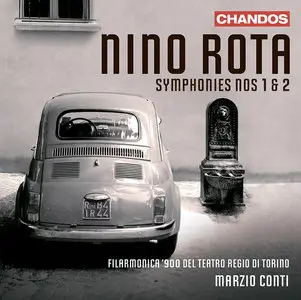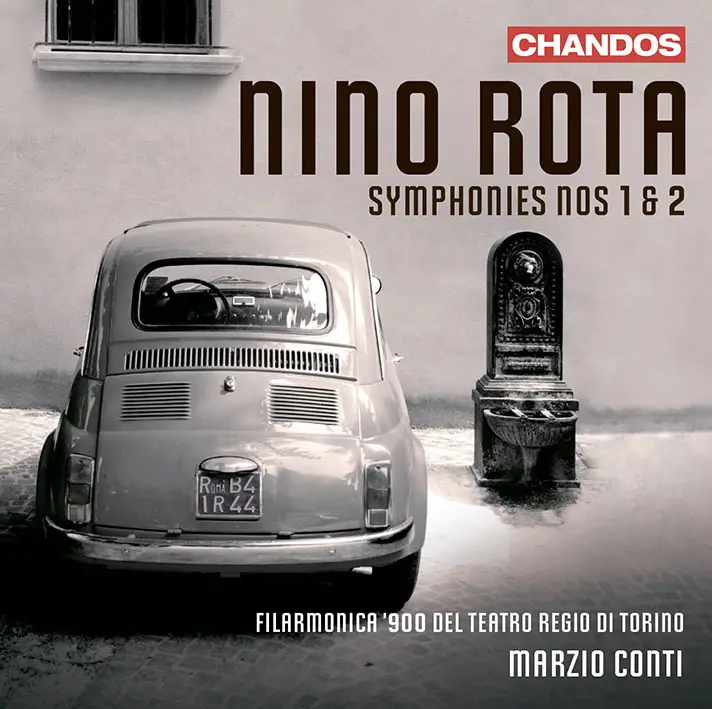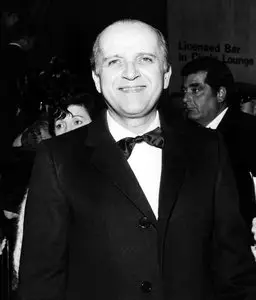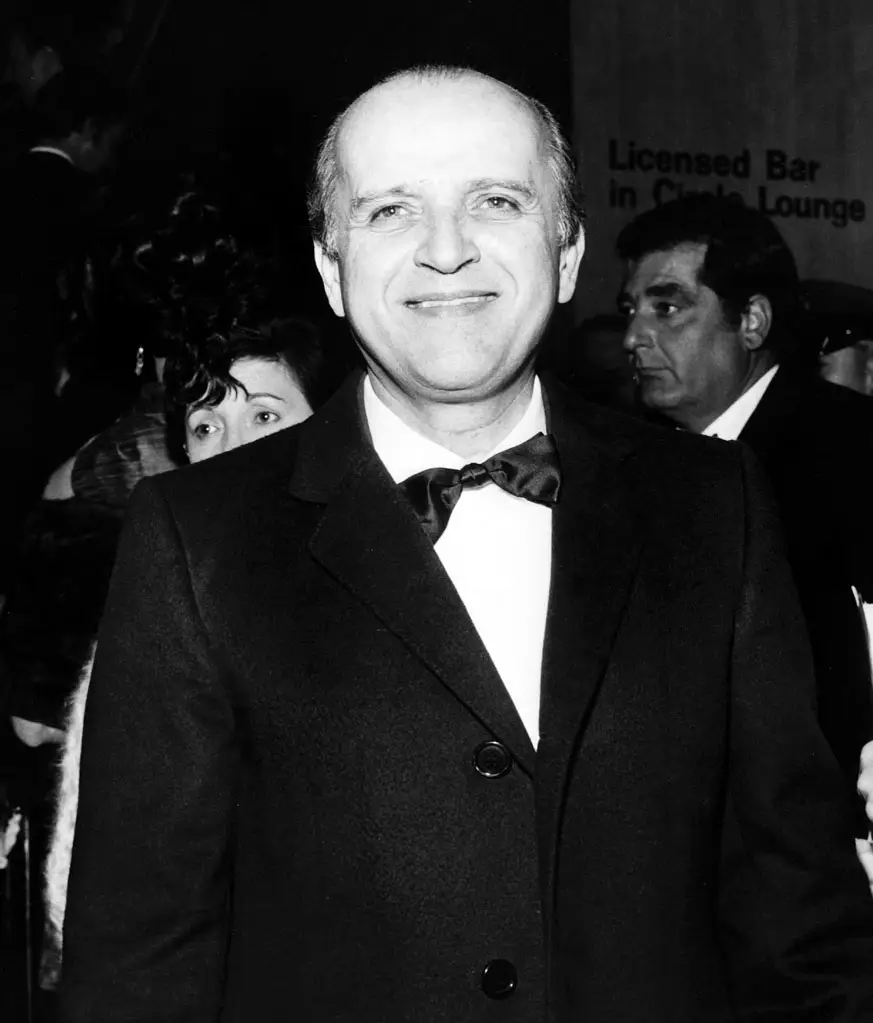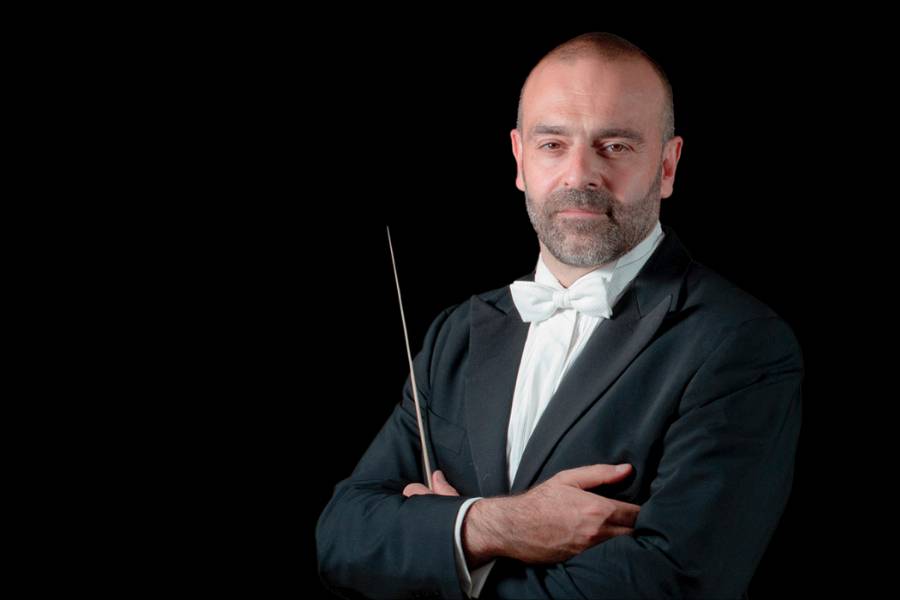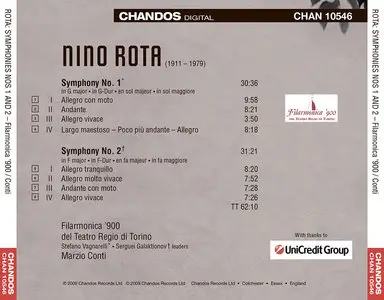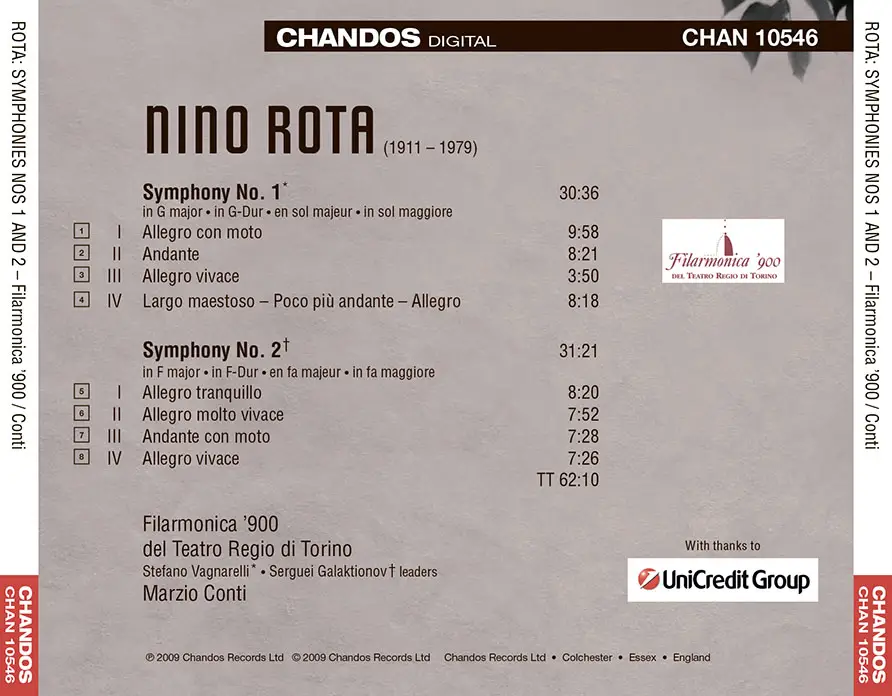Nino Rota - Symphonies Nos. 1 & 2 (2009)
Filarmonica ’900 del Teatro Regio di Torino, conducted by Marzio Conti
EAC | FLAC | Image (Cue&Log) ~ 278 Mb | Mp3 (CBR320) ~ 146 Mb | Scans included
Genre: Classical | Label: Chandos Records | # CHAN 10546 | Time: 01:02:10
Filarmonica ’900 del Teatro Regio di Torino, conducted by Marzio Conti
EAC | FLAC | Image (Cue&Log) ~ 278 Mb | Mp3 (CBR320) ~ 146 Mb | Scans included
Genre: Classical | Label: Chandos Records | # CHAN 10546 | Time: 01:02:10
The concert works of film composer Nino Rota, best known for his scores for the Godfather trilogy and for a long series of films by Federico Fellini, have increasingly often been finding space in classical recording catalogs. Here's a nicely recorded rendering of Rota's two numbered symphonies, virtually unknown until perhaps the turn of the century, issued on a major British label, Chandos. Both are attractive pieces that could be profitably programmed by any symphony orchestra. They were composed in the 1930s, when Rota was as much American as Italian; he won a scholarship to the Curtis Institute in Philadelphia and studied there for several years. Both reflect the French neo-classic trends that flourished in the U.S. between the wars, and, although Rota sounds nothing like Copland, you do experience in these works an evocation of what annotator Michele Rene Mannucci aptly calls "landscape in sound." Each work is in the conventional four movements, with a slow movement placed second in the Symphony No. 1 in G major and third in the Symphony No. 2 in F major. The opening movement in each work has a pastoral tinge. The question of whether Rota the celebrated film composer is audible in these symphonies can receive only a qualified answer. Judged from the perspective of Rota's circus-like Fellini scores, the answer is no. But the outer movements especially of each symphony have an episodic, colorful quality strongly suggesting what is to come, and the themes are strong enough throughout to support this kind of structure. The performances by the intricately named Filarmonica '900 del Teatro Regio di Torino under Marzio Conti seem entirely attuned to Rota's style and are crisp, accomplished, and generally a lot of fun. Mannucci's notes are given in French, English, German, and Italian.Review by James Manheim, Allmusic.com
For years (though I missed it this year), my spring ritual has been to open the windows on that first day in the year that IS spring: cool yet bright, with some fast-moving clouds. I clean my room and blast Rodrigo's Concierto de Aranjuez until my speakers cry "Uncle". There are two pieces that can put my soul smack dab in the middle of spring, no matter the season, no matter what is falling apart, no matter how hopeless anything looks. The mental slush vanishes, and I want to fall in love with (nearly) every woman who walks by. The Rodrigo and Canteloube's Songs of the Auvergne do this to me.
Well, now I've found a third piece, Nino Rota's Symphony 1. And when it's so tenderly and caringly played as it is here, I can't help but melt. There is just enough drama to keep the music from being saccharine; and Rota, best known as a film-score composer, is a master of timing. The music is very tonal, warm, and bright; the only thing I wanted more of is rhythmic variety, though the hemiolas in III help. (Hemiolas are different ways of accenting the rhythm when the music is in a fast 3 or 6; think of the line "I like to be in America!" from West Side Story.) The playing gets a little rough in III, but it doesn't harm the music at all.
Symphony 2 is titled Anni di Pellegrinaggio– Tarantina; the liner notes say this is "undoubtedly a reference to the new kind of life-style which he was beginning to enjoy, having just moved from the chaotic bustle of Rome to sunny Puglia". Like Symphony 1, it was completed in the late 1930s, though not performed until 1975. II is a tarantella with a dramatic, lush slowdown about two-thirds of the way in that suddenly brought Star Wars to mind. Rota keeps you in suspense, making you wonder if he'll bring the tarantella back at the very end; I won't ruin the surprise. The opening of III, Andante con Moto, reminds me of I of Gorecki's Symphony 3 with its dark, restless, contrapuntal lines in the lower reaches of the orchestra. The skies light up partway through, and the symphony ends with a lovely Allegro Vivace that has echoes of Dvorak's Symphony 8.
I wouldn't listen to the symphonies back to back; they're too similar in mood for that, but each would make a worthwhile 30 minutes on its own. The orchestra plays very well, and the sound is just right. Mark Lehman spoke highly of the Norrkoping Symphony's recording with Ole Kristian Ruud (BIS 970, J/F 1999), noting its "fine performances, superb sonics, and interesting, informative documentation". Notes in English, German, French, and Italian. – American Record Guide, Stephen Estep, November-December 2009
Many film composers have written "serious" music and many "serious" composers have written film music, but few have done both as well and as memorably as Nino Rota. Lately, I've been enjoying an excellent recording from 2002 of his music (unencumbered, unlike the official soundtrack recording, by the film's dialogue) for Franco Zeffirelli's Romeo and Juliet (Silva America 1140). It is, in a way, reassuring to juxtapose that CD and the present one and to note the composer's consistency of voice. One never feels that Rota is deceiving us (or himself) in any of his music, or that he is putting on clothing that doesn't fit him.
The first two of Rota's three numbered symphonies date from the composer's twenties, as he was completing his academic work–both in Italy and at the Curtis Institute of Music–and beginning a career as a teacher of harmony and composition in the Italian hinterlands. His first assignment as a film composer came in 1933, two years before he began work on the Symphony No. 1. Moving to Taranto in 1937 and then Bari two years later gave Rota the opportunity to reflect on his experiences up until then, and to digest them. It also tended to isolate him from exposure to avant-garde elements. It probably is an oversimplification to say that a simpler way of life reinforced, if not a simpler style of music, at least a clearer one.
There is an appealing pastoral element in both of these resolutely tonal symphonies, particularly in the Second, which is subtitled "Tarantina–Years of Pilgrimage." Chandos's annotator makes a case that Ralph Vaughan Williams's music influenced Rota. This might seem unlikely, but apparently the two men frequently were under the same roof–Arturo Toscanini's roof, as a matter of fact–in the years before these symphonies were composed. I can just about hear a little Vaughan Williams in these works if I try. The pastoral element has been heated, however, by the warmth of the Italian sun, and so one also hears affinities with Respighi in these works, and also with Casella.
It's been just over a decade since these symphonies were recorded by the Norrkoping Symphony Orchestra conducted by Ole Kristian Ruud (BIS 970). One might guess that an Italian orchestra and conductor have the advantage here. Nevertheless, I think a good case can be made for preferring BIS to Chandos. First, the Swedish orchestra is more polished than the one from Turin, which on occasion sounds hoarse. Second, BIS's engineering is superior, giving not just a sense of the orchestra, but also of the hall in which it is playing. (Chandos's sound brings the orchestra closer and spotlights individual instruments more.) Ruud and Conti see eye-to-eye on how this music should go, however; tempos are similar, and neither conductor makes weird interpretive choices. Sometimes (for example, in the last movement of the Symphony No. 2), Conti seems to be having a little more fun than Ruud, and he is more flexible, but the differences are not marked enough to be decisive. Either way, most listeners will find these genial, undemanding symphonies pleasing, if not particularly earth shattering.Review by Raymond Tuttle, Fanfare Magazine
Tracklist:
Symphony No.1 in G major
01. I. Allegro con moto (09:59)
02. II. Andante (08:21)
03. III. Allegro vivace (03:49)
04. IV. Largo maestoso - Poco piu andante - Allegro (08:18)
Symphony No.2 in F major
05. I. Allegro tranquillo (08:20)
06. II. Allegro molto vivace (07:52)
07. III. Andante con moto (07:28)
08. IV. Allegro vivace (07:28)
Exact Audio Copy V1.0 beta 3 from 29. August 2011
EAC extraction logfile from 6. May 2013, 11:29
Filarmonica '900 del Teatro Regio di Torino, Marzio Conti / Rota - Symphonies Nos. 1 & 2
Used drive : HL-DT-STDVDRRW GWA-4164B Adapter: 5 ID: 0
Read mode : Secure
Utilize accurate stream : Yes
Defeat audio cache : Yes
Make use of C2 pointers : No
Read offset correction : 102
Overread into Lead-In and Lead-Out : No
Fill up missing offset samples with silence : Yes
Delete leading and trailing silent blocks : No
Null samples used in CRC calculations : Yes
Used interface : Native Win32 interface for Win NT & 2000
Used output format : User Defined Encoder
Selected bitrate : 896 kBit/s
Quality : High
Add ID3 tag : No
Command line compressor : C:\Program Files\Exact Audio Copy\FLAC\FLAC.EXE
Additional command line options : -V -8 %source%
TOC of the extracted CD
Track | Start | Length | Start sector | End sector
––––––––––––––––––––––––––––-
1 | 0:00.00 | 10:03.63 | 0 | 45287
2 | 10:03.63 | 8:25.50 | 45288 | 83212
3 | 18:29.38 | 3:49.59 | 83213 | 100446
4 | 22:19.22 | 8:27.16 | 100447 | 138487
5 | 30:46.38 | 8:24.45 | 138488 | 176332
6 | 39:11.08 | 7:56.55 | 176333 | 212087
7 | 47:07.63 | 7:33.00 | 212088 | 246062
8 | 54:40.63 | 7:28.12 | 246063 | 279674
Range status and errors
Selected range
Filename C:\temp\Rota - Symphonies Nos. 1 & 2\Rota - Symphonies Nos. 1 & 2.wav
Peak level 97.8 %
Extraction speed 2.7 X
Range quality 99.9 %
Test CRC F5725FED
Copy CRC F5725FED
Copy OK
No errors occurred
End of status report
==== Log checksum A04B95E934F5623DA9E3200F37503E3D20EB1D5F142520D0EE7F2D07883744C9 ====
EAC extraction logfile from 6. May 2013, 11:29
Filarmonica '900 del Teatro Regio di Torino, Marzio Conti / Rota - Symphonies Nos. 1 & 2
Used drive : HL-DT-STDVDRRW GWA-4164B Adapter: 5 ID: 0
Read mode : Secure
Utilize accurate stream : Yes
Defeat audio cache : Yes
Make use of C2 pointers : No
Read offset correction : 102
Overread into Lead-In and Lead-Out : No
Fill up missing offset samples with silence : Yes
Delete leading and trailing silent blocks : No
Null samples used in CRC calculations : Yes
Used interface : Native Win32 interface for Win NT & 2000
Used output format : User Defined Encoder
Selected bitrate : 896 kBit/s
Quality : High
Add ID3 tag : No
Command line compressor : C:\Program Files\Exact Audio Copy\FLAC\FLAC.EXE
Additional command line options : -V -8 %source%
TOC of the extracted CD
Track | Start | Length | Start sector | End sector
––––––––––––––––––––––––––––-
1 | 0:00.00 | 10:03.63 | 0 | 45287
2 | 10:03.63 | 8:25.50 | 45288 | 83212
3 | 18:29.38 | 3:49.59 | 83213 | 100446
4 | 22:19.22 | 8:27.16 | 100447 | 138487
5 | 30:46.38 | 8:24.45 | 138488 | 176332
6 | 39:11.08 | 7:56.55 | 176333 | 212087
7 | 47:07.63 | 7:33.00 | 212088 | 246062
8 | 54:40.63 | 7:28.12 | 246063 | 279674
Range status and errors
Selected range
Filename C:\temp\Rota - Symphonies Nos. 1 & 2\Rota - Symphonies Nos. 1 & 2.wav
Peak level 97.8 %
Extraction speed 2.7 X
Range quality 99.9 %
Test CRC F5725FED
Copy CRC F5725FED
Copy OK
No errors occurred
End of status report
==== Log checksum A04B95E934F5623DA9E3200F37503E3D20EB1D5F142520D0EE7F2D07883744C9 ====
[CUETools log; Date: 25.01.2014 18:48:56; Version: 2.1.4]
[CTDB TOCID: bIpnJi1UtGJDb.1xsoW.UvWu9c0-] found.
Track | CTDB Status
1 | (3/3) Accurately ripped
2 | (3/3) Accurately ripped
3 | (3/3) Accurately ripped
4 | (3/3) Accurately ripped
5 | (3/3) Accurately ripped
6 | (3/3) Accurately ripped
7 | (3/3) Accurately ripped
8 | (3/3) Accurately ripped
[AccurateRip ID: 00138e3b-0081212d-600e9108] found.
Track [ CRC | V2 ] Status
01 [5623ffe3|ac6aea63] (2+3/5) Accurately ripped
02 [3869cad5|12f624cc] (2+3/5) Accurately ripped
03 [32c736a1|acf9f3ff] (2+3/5) Accurately ripped
04 [eadd288d|a8862e94] (2+3/5) Accurately ripped
05 [0641b420|00552b22] (2+4/6) Accurately ripped
06 [03067dee|2c1da9cd] (2+4/6) Accurately ripped
07 [7c8498b4|480e6968] (2+3/5) Accurately ripped
08 [dd5c5855|f9097082] (2+3/5) Accurately ripped
Track Peak [ CRC32 ] [W/O NULL] [ LOG ]
– 97,8 [F5725FED] [619F657F] CRC32
01 97,8 [9A4E5251] [0A47036E]
02 97,6 [323D4408] [D6CF340E]
03 97,6 [4DFFC5B3] [7FAA5FB1]
04 97,8 [DD90A47D] [81867757]
05 90,9 [9B527C8B] [40B203BA]
06 97,6 [A8FB78F5] [075635D9]
07 97,6 [E266C7B6] [A13DE24E]
08 97,8 [DE101D74] [E5687DAE]
[CTDB TOCID: bIpnJi1UtGJDb.1xsoW.UvWu9c0-] found.
Track | CTDB Status
1 | (3/3) Accurately ripped
2 | (3/3) Accurately ripped
3 | (3/3) Accurately ripped
4 | (3/3) Accurately ripped
5 | (3/3) Accurately ripped
6 | (3/3) Accurately ripped
7 | (3/3) Accurately ripped
8 | (3/3) Accurately ripped
[AccurateRip ID: 00138e3b-0081212d-600e9108] found.
Track [ CRC | V2 ] Status
01 [5623ffe3|ac6aea63] (2+3/5) Accurately ripped
02 [3869cad5|12f624cc] (2+3/5) Accurately ripped
03 [32c736a1|acf9f3ff] (2+3/5) Accurately ripped
04 [eadd288d|a8862e94] (2+3/5) Accurately ripped
05 [0641b420|00552b22] (2+4/6) Accurately ripped
06 [03067dee|2c1da9cd] (2+4/6) Accurately ripped
07 [7c8498b4|480e6968] (2+3/5) Accurately ripped
08 [dd5c5855|f9097082] (2+3/5) Accurately ripped
Track Peak [ CRC32 ] [W/O NULL] [ LOG ]
– 97,8 [F5725FED] [619F657F] CRC32
01 97,8 [9A4E5251] [0A47036E]
02 97,6 [323D4408] [D6CF340E]
03 97,6 [4DFFC5B3] [7FAA5FB1]
04 97,8 [DD90A47D] [81867757]
05 90,9 [9B527C8B] [40B203BA]
06 97,6 [A8FB78F5] [075635D9]
07 97,6 [E266C7B6] [A13DE24E]
08 97,8 [DE101D74] [E5687DAE]
foobar2000 1.2 / Dynamic Range Meter 1.1.1
log date: 2014-01-18 17:56:23
––––––––––––––––––––––––––––––––––––––––
Analyzed: Filarmonica '900 del Teatro Regio di Torino, Marzio Conti / Rota - Symphonies Nos. 1 & 2
––––––––––––––––––––––––––––––––––––––––
DR Peak RMS Duration Track
––––––––––––––––––––––––––––––––––––––––
DR13 -0.19 dB -18.51 dB 10:04 01-Symphony No.1 in G major - I. Allegro con moto
DR14 -0.21 dB -20.10 dB 8:26 02-Symphony No.1 in G major - II. Andante
DR10 -0.21 dB -16.67 dB 3:50 03-Symphony No.1 in G major - III. Allegro vivace
DR12 -0.19 dB -17.57 dB 8:27 04-Symphony No.1 in G major - IV. Largo maestoso - Poco piu andante - Allegro
DR14 -0.82 dB -21.45 dB 8:25 05-Symphony No.2 in F major - I. Allegro tranquillo
DR12 -0.21 dB -17.90 dB 7:57 06-Symphony No.2 in F major - II. Allegro molto vivace
DR12 -0.21 dB -18.13 dB 7:33 07-Symphony No.2 in F major - III. Andante con moto
DR13 -0.19 dB -17.75 dB 7:28 08-Symphony No.2 in F major - IV. Allegro vivace
––––––––––––––––––––––––––––––––––––––––
Number of tracks: 8
Official DR value: DR13
Samplerate: 44100 Hz
Channels: 2
Bits per sample: 16
Bitrate: 616 kbps
Codec: FLAC
================================================================================
log date: 2014-01-18 17:56:23
––––––––––––––––––––––––––––––––––––––––
Analyzed: Filarmonica '900 del Teatro Regio di Torino, Marzio Conti / Rota - Symphonies Nos. 1 & 2
––––––––––––––––––––––––––––––––––––––––
DR Peak RMS Duration Track
––––––––––––––––––––––––––––––––––––––––
DR13 -0.19 dB -18.51 dB 10:04 01-Symphony No.1 in G major - I. Allegro con moto
DR14 -0.21 dB -20.10 dB 8:26 02-Symphony No.1 in G major - II. Andante
DR10 -0.21 dB -16.67 dB 3:50 03-Symphony No.1 in G major - III. Allegro vivace
DR12 -0.19 dB -17.57 dB 8:27 04-Symphony No.1 in G major - IV. Largo maestoso - Poco piu andante - Allegro
DR14 -0.82 dB -21.45 dB 8:25 05-Symphony No.2 in F major - I. Allegro tranquillo
DR12 -0.21 dB -17.90 dB 7:57 06-Symphony No.2 in F major - II. Allegro molto vivace
DR12 -0.21 dB -18.13 dB 7:33 07-Symphony No.2 in F major - III. Andante con moto
DR13 -0.19 dB -17.75 dB 7:28 08-Symphony No.2 in F major - IV. Allegro vivace
––––––––––––––––––––––––––––––––––––––––
Number of tracks: 8
Official DR value: DR13
Samplerate: 44100 Hz
Channels: 2
Bits per sample: 16
Bitrate: 616 kbps
Codec: FLAC
================================================================================


